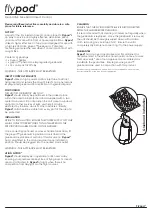
Chapter 5
Setup and Configuration
RUGGEDCOM ROX II
User Guide
476
Managing RIP
Section 5.20
Managing RIP
The Routing Information Protocol (RIP) determines the best path for routing IP traffic over a TCP/IP network
based on the number of hops between any two routers. It uses the shortest route available to a given network as
the route to use for sending packets to that network.
The ROX II RIP daemon is an
[http://tools.ietf.org/rfc/rfc1058.txt] compliant implementation of RIP
that supports RIP version 1 and 2. RIP version 1 is limited to obsolete class-based networks, while RIP version 2
supports subnet masks, as well as simple authentication for controlling which routers to accept route exchanges
with.
RIP uses network and neighbor entries to control which routers it will exchange routes with. A network is either
a subnet or a physical (broadcast-capable) network interface. Any router that is part of that subnet or connected
to that interface may exchange routes. A neighbor is a specific router, specified by its IP address, to exchange
routes with. For point to point links (i.e. T1/E1 links), neighbor entries must be used to add other routers to
exchange routes with. The maximum number of hops between two points on a RIP network is 15, placing a limit
on network size.
Link failures will eventually be noticed when using RIP, although it is not unusual for RIP to take many minutes
for a dead route to disappear from the whole network. Large RIP networks could take over an hour to converge
when link or route changes occur. For fast convergence and recovery, OSPF is recommended. For more
information about OSPF, refer to
.
RIP is a legacy routing protocol that has mostly been superseded by OSPF.
NOTE
In complex legacy networks, RIP, OSPF, BGP and IS-IS may all be active on the same router at the
same time. Typically, however, only one dynamic routing protocol is employed at one time.
The following sections describe how to configure and manage RIP:
•
Section 5.20.1, “Configuring RIP”
•
Section 5.20.2, “Viewing the Status of Dynamic RIP Routes”
•
Section 5.20.3, “Managing Prefix Lists and Entries”
•
Section 5.20.4, “Managing Networks”
•
Section 5.20.5, “Managing Network IP Address”
•
Section 5.20.6, “Managing Network Interfaces”
•
Section 5.20.7, “Managing Neighbors”
•
Section 5.20.8, “Managing the Prefix List Distribution”
•
Section 5.20.9, “Managing Key Chains and Keys”
•
Section 5.20.10, “Managing Redistribution Metrics”
•
Section 5.20.11, “Managing Routing Interfaces”
Section 5.20.1
Configuring RIP
To configure dynamic routing using the Routing Information Protocol (RIP) daemon, do the following:
1. Change the mode to
Edit Private
or
Edit Exclusive
.
Содержание RUGGEDCOM RX1510
Страница 32: ...RUGGEDCOM ROX II User Guide Preface Customer Support xxxii ...
Страница 44: ...RUGGEDCOM ROX II User Guide Chapter 1 Introduction User Permissions 12 ...
Страница 62: ...RUGGEDCOM ROX II User Guide Chapter 2 Using ROX II Using the Command Line Interface 30 ...
Страница 268: ...RUGGEDCOM ROX II User Guide Chapter 4 System Administration Deleting a Scheduled Job 236 ...
Страница 852: ...RUGGEDCOM ROX II User Guide Chapter 5 Setup and Configuration Enabling Disabling an LDP Interface 820 ...
















































